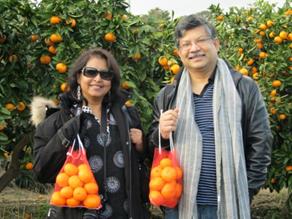Mikkabi Mikan
During a sightseeing tour of the Lake Okuhamanako region held in December 2012 for Japan-based foreign diplomats, 33 diplomats and their family members from 12 countries visited the town of Mikkabi-cho in Shizuoka Prefecture, which is famous for its mikan (tangerine or mandarin orange) production, and enjoyed mikan picking there. Mikkabi mikan are well known throughout Japan as high-class oranges, and the tour participants gave them the thumbs-up as well, remarking with approval that they were “very tasty indeed.” IHCSA Café asked Mr. Hiroyuki Toyama, who manages the Marukei mikan farm, about the characteristics of Mikkabi mikan and other issues.
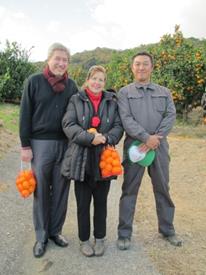
The ambassador of Uruguay, his wife, and Mr. Toyama
What are the characteristics of Mikkabi mikan?
It’s probably the fact that compared with oranges from such production areas as Ehime, Kumamoto, and Wakayama, they have a somewhat sour taste. Added to the sweetness, this moderate sourness gives them a fresh, juicy, and fruit-like flavor. Another major characteristic is their full-bodied flavor, which is thanks to the well-drained soil we are blessed with here. These two qualities, the moderate sourness and the richness, linger for a long time in your mouth and make you want to eat another.
What is the method for growing tasty mikan? What do you take special care about on your farm?
At our farm, however much it might produce tastier fruit, we take care not to place excessive stress on the trees by reducing the amount of water and fertilizer too much. Also, more than the part above ground, we look after the underground part, the roots. And we make sure not to rush harvesting. We are careful to let the mikan ripen on the trees and only harvest them when they are the right color, in other words, when they are most tasty.
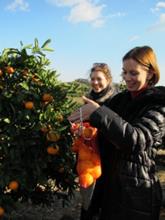
Diplomats enjoy picking mikan.
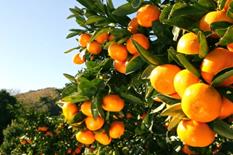
Aoshima mikan
What kind of orange is the Aoshima variety of Mikkabi mikan?
In many people’s minds, the Aoshima variety has become synonymous with Mikkabi mikan. Aoshima oranges mainly become available nationwide after the start of the New Year. As the name suggests, the variety was discovered by a person called Aoshima. They are a little larger and flatter than other varieties. The thickness of the skin maybe puts some people off, but they have a much stronger sweet taste than other citrus fruits eaten before the end of the year.
How are Mikkabi mikan usually distributed?
One of our weak points is that because our production area is just a small town, the lots shipped from Mikkabi-cho are smaller than those shipped from other production areas. The distribution cooperative takes charge of shipments to markets mainly in the metropolitan Tokyo region. Mikkabi mikan can also be purchased online via the Agri Mikkabi Mika-chan Shop of JA Mikkabi, the local agricultural cooperative [http://www.rakuten.ne.jp/gold/mikkabi/].
Mikkabi-cho has been successful with the branding of its mikan and does not seem to face such problems as finding successors to carry on the farm work in the future. What are the important factors for the brand, and what are the reasons for the branding success?
Well, the successor problem is a major issue in Mikkabi-cho as well, but efforts are being made to create an easier working environment for young people. For example, fields are not all steep slopes. Improvements and adjustments have been made so that machinery can be easily brought in.
Also, whereas oranges from such production areas as Ehime, Kumamoto, and Wakayama mainly cease circulating by the end of the year, Mikkabi and other Shizuoka mikan continue to circulate from the beginning of the New Year until March or April. I think the main reason for the establishment of the Mikkabi brand lay in the improvement of cultivated varieties in response to this competition among production areas.
There is no doubt that the distribution cooperative played an important role in

JA Mikkabi‘s high-tech sorting factory
establishing the brand as well. Of course, there are shipments of individual brands, including our farm, but nevertheless the main actor is the distribution cooperative. By making it obligatory for cooperative members to ship certain quantities, the distribution cooperative has been able to maintain the shipment quantities of the production area as a whole and make efforts to ensure the shipment of high-quality oranges. In addition, advanced quality management is carried out at the high-tech sorting factory of JA Mikkabi, with sensors instantly sorting mikan by size, detecting blemishes, and measuring sugar content. Such infrastructure is an important factor in maintaining the brand.
In recent years there has been a lot of talk about recycle-oriented farming and promotion of the so-called sextiary sector* in agriculture [processed products]. Are mikan farms in Mikkabi-cho making any efforts in this respect?
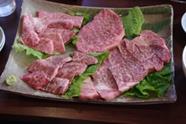
Mikkabi beef
Well, first of all, the dregs of mikan juice are being mixed into the livestock feed of Mikkabi-cho cows, and then the cow manure is being returned to the mikan fields as fertilizer. Also, we prune the tree branches in winter, and now there are many farmers who use machines to return them to the fields as chips.
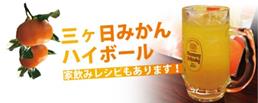 Regarding the so-called sextiary sector, JA Mikkabi has begun selling frozen oranges called Kori Mikan. These frozen mikan have already been peeled, so they can be eaten immediately without the bother of removing the skin. I hope that this item becomes a summertime staple in the future. In addition, with younger consumers in mind, Suntory and JA Mikkabi recently developed a product called the Mikkabi Mikan Highball, which went on sale nationwide in a limited winter edition.
Regarding the so-called sextiary sector, JA Mikkabi has begun selling frozen oranges called Kori Mikan. These frozen mikan have already been peeled, so they can be eaten immediately without the bother of removing the skin. I hope that this item becomes a summertime staple in the future. In addition, with younger consumers in mind, Suntory and JA Mikkabi recently developed a product called the Mikkabi Mikan Highball, which went on sale nationwide in a limited winter edition.
There are many people who individually or in groups are developing new products using mikan, such as juices, jams, or canned oranges. At our farm, we are trying to develop a variety of new products, such as leaf tea using the young leaves of mikan trees, washi paper using mikan fiber, and jarred mikan of easy-to-eat portions.
*Agricultural production itself is a primary industry. The so-called sextiary sector refers to agricultural management that diversifies into the secondary and tertiary industries, becoming involved, for example, in the manufacture and sale of processed food products and services utilizing local resources, such as tourist farms, thereby endeavoring to promote regional revitalization.
As a mikan farm owner, and also a cooperative member, what are your hopes regarding the relationship between mikan, a specialty of Shizuoka Prefecture, and tourism in the future?
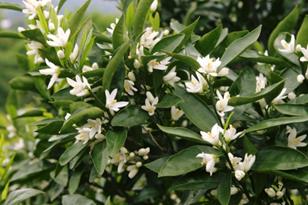
Mikan flowers
The business of mikan-picking farms has fallen off a bit lately, and I think there is a limit to the extent to which we can make a nationwide appeal for Mikkabi-cho only through mikan themselves. As well as simply promoting mikan for eating in the winter, I think that we need to be advertising throughout the year and highlighting such things as mikan tree flowers, which come into full blossom after the beginning of May, and aomikan [green tangerines], which are plucked in large quantities during the summer
work. It is important for not only farmers but local residents as well to pool their ideas and work together to advertise Mikkabi-cho as a whole and ultimately the Okuhamanako area as a whole.
What do you think are the prospects for Mikkabi mikan in the global economy?
Acquaintances have told me that they want to take mikan to Britain and popularize them there or make them more popular in Canada. I am told that there is nothing overseas like mikan, which you can peel with your own hands. I suppose business development will focus on processed goods. But I am confident of the good taste, so I see that as a springboard for spreading the word about Japanese mikan, Mikkabi mikan, and Aoshima mikan.
